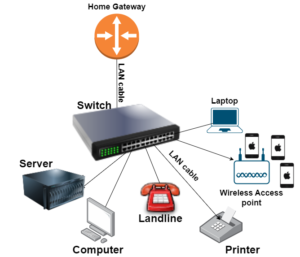A local area network (LAN) is a network architecture that is often mistaken for a wide area network (WAN) or Metropolitan Area Network (MAN); however, it has distinct differences from them.
A Local Area Network (LAN) is utilized to provide internet connectivity within a limited area, typically a building, room, or even just one or two computers.
In this article, we will focus on Local Area Network architecture, specifically how LAN link is derived from a Wide Area Network (WAN) link and then disseminated to end-host devices using switches.
Local Area Network Architecture
Local area network architecture consists of various host devices or extenders like personal computers, office phones, printers, and wireless access points, all interconnected through a switch.

The internet link coming from your ISP, whether it’s a fiber cable or a twisted pair cable, is the WAN link and is run directly to your home gateway. This gateway (router) now transforms the link into a LAN link, providing a port to which a switch can be attached for further distribution of the link.
Here are the components of a local area network:
- Customer Edge Router: The customer edge router, usually referred to as the home gateway, is the initial component in a local area network. The internet link coming from the ISP goes directly to the customer’s edge router. This router converts the link from the WAN to a LAN link and provides a port where the switch can pick up the LAN link for further distribution. This router serves the purpose of forwarding all the traffic coming from the LAN to the internet using IP routing protocols.
- Switches: The next component in a LAN after the customer edge router is the switch. The switch takes in the LAN link from the router and then distributes it to a larger number of host devices through its multiple LAN ports. The switch showcased in the topology above has up to 48 LAN ports. Devices connected to a switch can communicate directly without the packet having to traverse the router, except in cases where VLANs are configured with the switch.
- Ethernet Cable (LAN Cable): The next network component in a LAN architecture is the Ethernet cable. This cable is usually a twisted cable that has an RJ45 connector connected to each of its two ends. This port allows the cable to be attached to the switch’s Ethernet port and to the host device’s RJ45 port. As shown in the network topology above, we have utilized Ethernet cables to connect some of the host devices to the bottom row of the switch.
- Host Devices: Host devices are user equipment that makes use of the internet. Host devices are the devices that need to communicate either with the internet or with each other. Host devices can be personal computers, printers, mobile phones, or any other user equipment used to access the internet or communicate with other hosts. In the architecture above, I have also attached a wireless access point as a host device. This helps to provide wireless connectivity to user equipment like mobile phones or personal computers using Wi-Fi technology.
How Packet Move in a Local Area Network
Packet movement in a LAN is not as complex as in a wide-area network. When devices within a LAN need to communicate, the packets generated by user applications do not travel to the internet. Host devices on a network can communicate directly with each other.
The only instance when packet movement in a LAN is complicated is when a host device initiates a request to the internet from another host device situated outside the LAN. In this scenario, the switch is required to forward the packet to the router, which then routes it to the WAN, or global internet.

I am a passionate Networking Associate specializing in Telecommunications.
With a degree in Electronic engineering, I possess a strong understanding of electronic systems and the intricacies of telecommunications networks. I gained practical experience and valuable insights working for a prominent telecommunications company.
Additionally, I hold certifications in networking, which have solidified my expertise in network architecture, protocols, and optimization.
Through my writing skills, I aim to provide accurate and valuable knowledge in the networking field.
Connect with me on social media using the links below for more insights.
You can contact me using [email protected] or connect with me using any of the social media account linked below



Alexander brilliantly demystifies Local Area Network architecture, unraveling its intricacies and showcasing the seamless interplay of components in fostering efficient internet connectivity within confined spaces.